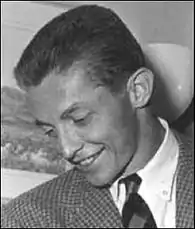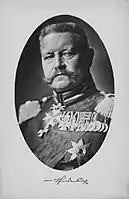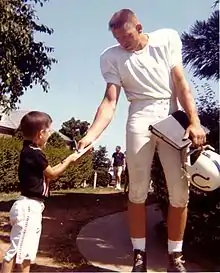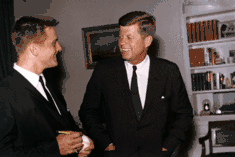Flattop
A "flattop" is a type of short haircut where the hair on the top of the head is usually standing upright and cut to form a flat-appearing deck. This deck may be level, or it may be upward or downward sloping. This type of haircut is usually performed with electric clippers, either freehand or using the clipper-over-comb method.[1][2][3][4]

Styling
When a flattop is viewed from the front, varying degrees of squarish appearance are achieved by the design of the upper sides as they approach and round or angle on to the flat deck.[5][6] Possibilities are somewhat limited by skull shape, the density of the hair and the diameter of the individual shafts of hair, but may include: boxy upper sides with rounded corners; boxy upper sides with sharp corners; rounded upper sides with rounded corners; rounded upper sides with sharp corners.[5] The hair on the sides and back of the head is usually tapered short, semi-short, or medium.[6][7]
A flattop might be graduated in length on the top of the head from one and a half inches at the front hairline to about a quarter inch at the crown to a half inch as it starts curving down the back of the head, tapering to the skin near the middle of the ears.[8] A variant form known by several names including flattop with fenders and flat top boogie has long sides known as fenders with or without a ducktail.[9][10]
Flattops are traditionally groomed with hair control wax, commonly referred to as butch wax. Certain hair textures do not require waxes or straighteners to maintain their hold. Since the haircut is short and quickly grows out of its precisely-cut shape, maintenance haircuts are required at least every few weeks, and some flattop wearers get haircuts as often as once a week.
The flattop has maintained a contingent of dedicated wearers since it was introduced. It was very popular in the 1950s, but faded in popularity with the emergence of longer hair styles in the late 1960s and 1970s. It had a brief reappearance in the 1980s and early 1990s, before dropping off again.
 German general Paul von Hindenburg with flattop, 1914
German general Paul von Hindenburg with flattop, 1914 Johnny Unitas, who wore a flattop during much of his NFL career
Johnny Unitas, who wore a flattop during much of his NFL career NASA astronaut Walter Cunningham with a flattop
NASA astronaut Walter Cunningham with a flattop Flight director Gene Kranz wore a flattop ever since the early Apollo missions.
Flight director Gene Kranz wore a flattop ever since the early Apollo missions.
Haircutting methods

The haircut is usually done with electric clippers utilizing the clipper over comb technique, though it can also be cut shears over comb or freehand with a clipper.[7][11] Some barbers utilize large combs designed for cutting flattops. Others use wide rotary clipper blades specifically designed for freehand cutting the top of a flattop.[12]
When cutting a new flattop or when cutting a flattop with full boxy or boxy rounded upper sides or a flattop with fenders, the hair at the upper sides and top has to be boxed in. If the hair on the upper sides is initially contoured, it may not be possible to achieve a squarish effect.[6] The hair at the crown is cut from about one quarter to one half inch while the barber stands behind the patron. He then positions himself in front and cuts the top hair to about two inches in length and then to the desired height across the top from side to side while progressing back to the shorter hair at the crown.
The exact lengths are dependent on skull shape and the style of flat top.[7] Intricate cutting of the deck and upper sides follows to achieve a specific inclination and squarish effect. Natural skull shape and certain deck inclinations and heights often leave an area at the center top of the head where the scalp is visible through the hair. This area is called a "landing strip", a metaphor for the landing strip on the deck of a flattop (aircraft carrier). Some flattops are designed to cause a landing strip to show to varying degrees.[6]
See also
References
- Thorpe 1967, pp. 133–134.
- Trusty 1971, pp. 110–111.
- "MANNERS & MORALS: Teen-Age Moderation". Time. 16 February 1959.
- Victoria Sherrow (2006), Encyclopedia of hair, ISBN 9780313331459
- Thorpe 1967, p. 134.
- Trusty 1971, p. 110.
- Thorpe 1967, p. 133.
- "The Flat Top", Boys' Life, August 1961
- Trusty 1971, pp. 111–112.
- "The Flat Top Boogie", Boys' Life, July 1961
- Trusty 1971, pp. 110–112.
- Trusty 1971, p. 111.
Bibliography
- Thorpe, S.C. (1967). Practice and Science of Standard Barbering. Milady Publishing Corporation.CS1 maint: ref=harv (link)
- Trusty, L. Sherman (1971). The Art and Science of Barbering. Wolfer Printing Co.CS1 maint: ref=harv (link)
External links
 Media related to Flattop at Wikimedia Commons
Media related to Flattop at Wikimedia Commons- Information on flattops and list of famous flattop wearers
- Online community for flattop haircuts with barber shop recommendations
- Flattop, boxy, rounded corners
- Flattop, boxy, sharp corners, landing strip showing
- Flattop, rounded, rounded corners
- Flattop, rounded, sharp corners, landing strip showing
- How to give a flat top haircut
- How To Square Flattop Hair Life November 12, 1956. Includes photos.
 The dictionary definition of flattop at Wiktionary
The dictionary definition of flattop at Wiktionary